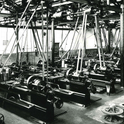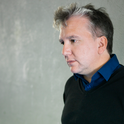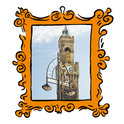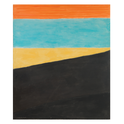Marcus du Sautoy—mathematician, author, playwright, educator and musician—is a modern polymath. He brings this vast knowledge to his new book, Blueprints: How Mathematics Shapes Creativity. In nine chapters, each focusing on a different element of mathematics, du Sautoy explores the fascinating and surprising ways in which the discipline has provided the structure for art, literature and music.
Du Sautoy begins his study with a straw man: the idea that, whereas art is creative and passionate, mathematics is unimaginative and cold. In fact, he says, “scratch the surface and one discovers that the two worlds have much more in common than one might expect.” Blueprints does much more than scratch that surface. From primes (the foundations of all numbers) to randomness (which he calls an “anti-blueprint”), du Sautoy explains the mathematical templates and describes how great artists have used them in their work.
Mathematical inspiration in art was notable in the late Middle Ages and early Renaissance. A key figure was Giotto, who won a papal commission after he impressed Benedict XI by drawing a circle without a compass. Giotto led an artistic revolution thanks to his use of space and perspective, which allowed him to more realistically portray the three-dimensional universe on a two-dimensional surface.
Giotto’s techniques were developed by mathematician-painters such as Piero della Francesca and Leonardo da Vinci. Piero, the author of several treatises on mathematics, employed geometry and parallel lines to create an extraordinary sense of depth—as seen in works such as The Flagellation of Christ. For his part, Leonardo used the golden ratio (a geometric proportion equivalent to 1.618) to plot the figures and objects of The Last Supper.
One of maths’ most significant blueprints across the arts is the circle—the symbol of transformation and completeness. In art, it has been explored by painters such as Kandinsky, Miró and Picasso. And literature has many circular narratives, from Alice in Wonderland (written by a mathematician) to Finnegans Wake, which ends with an unfinished sentence that is continued by the novel’s first line.
Johann Sebastian Bach did something similar in his Goldberg Variations—a work comprising an aria followed by 30 different compositions based on the aria’s bass line. After the 30th variation, Bach repeats the aria, recommencing a potentially endless piece of music.
Bach’s manuscript, which was not discovered until 1974, provides further mathematical intrigue. In particular, it includes 14 canons (a technique where the melody is imitated, some bars behind, by additional instruments or voices). Bach, who must have been in a playful mood, decided not to write out these canons in full, and left annotations that—if followed correctly—reveal the rest of the piece.
Uncovered, Bach’s fifth canon turns out to be a musical version of the Möbius strip—the twisted loop familiar to riders of two-track rollercoasters. Du Sautoy gives us an image of the score and explains:
The bottom line looks quite different to the top until we do something rather strange. Let’s peel off the top line. Imagine the top notes are written on a transparent piece of celluloid which is then twisted into a Möbius strip. When we go round the strip, the first half produces the first line; but as we are taken onto the back of the celluloid and read the notes from the reverse, we get the second line of music.
What Bach was doing was intuitive, and prefigured August Ferdinand Möbius’s work on the strip by more than a hundred years. Rather than mathematics being the basis for art, Bach’s fifth canon is a rare example of the arts pre-empting mathematics.
Claude Debussy could be similarly cryptic. In his orchestral symphony La Mer, he uses Fibonacci numbers—a series where each number is the sum of the previous two (1, 2, 3, 5, 8, 13, 21, 34, 55 and so on). For example, the 55-bar introduction to the last movement breaks down into five sections comprised of 21, 8, 8, 5, and 13 bars. What is more, the trombones come in just after bar 34, which corresponds to the golden ratio (55 ÷ 34 = 1.618).
Debussy didn’t like theorists who “try to explain things, and quite heartlessly kill all their mystery”, but he left a clue through the cover image of the score’s first edition: The Great Wave by Katsushika Hokusai. Hokusai’s woodblock print not only matches Debussy’s maritime theme, but the peak and trough of his wave have the proportions of the golden ratio.
Du Sautoy returns to The Great Wave in his chapter on fractals—shapes whose constituent parts resemble the whole (think of florets of romanesco broccoli). As he puts it, “The large wave that dominates the picture breaks up into smaller waves which mimic its shape, and these smaller waves in turn are made up of tiny claws of foam that retain the geometry of the overall arch of the large wave.”
Fractals are also used for computer-generated images in filmmaking and were a secret ingredient in the work of Jackson Pollock. Pollock, it was discovered decades after his death, used fractals so that his paintings would retain their complexity irrespective of their distance from the viewer. It was so intrinsic to his work that, when 32 “never-before-seen” Pollocks were presented in 2005, the physicist who uncovered his use of fractals could identify the canvases as fakes.
If maths is useful to art, then is art useful to maths? Du Sautoy thinks so. “If artists are secret mathematicians,” he writes, “then equally mathematicians are secret artists.” Mathematics operates within strict parameters, but there is space for artistic exploration. Creativity, he says, is invaluable to mathematical discovery.
Du Sautoy also argues that maths—like art—should aspire to beauty. Here, he follows in the tradition of GH Hardy, who wrote in A Mathematician’s Apology (1940): “A mathematician, like a painter or a poet, is a maker of patterns… Beauty is the first test: there is no permanent place in the world for ugly mathematics.”
Du Sautoy develops this idea in relation to AI, which he says needs to appreciate the beauty of the discipline before it can claim to be a “true mathematician”:
I can get a computer to churn out lots of new symmetrical structures that no one has seen before. They are new discoveries, so do they deserve their place in the journals and the seminar rooms alongside my proof? Until AI learns the aesthetics of how mathematics moves us, why we value it, I think the answer is no. At the moment it can’t distinguish between what is just a long, tedious calculation entirely lacking in excitement, and what is an epic intellectual journey that brings us to our feet in appreciation when we hear it.
Yet, whether it is conducted by humans or machines, this is rarely how maths is perceived. Our society clings to the contrived distinction between arts and sciences; and maths, as the most abstract science, is usually seen as the most removed from human creativity. It’s a misconception that partly explains why schoolchildren so often view maths as the bogeyman of the curriculum. However, as du Sautoy argues, we could instead see maths as the bridge between the “two cultures”, as a quantitative endeavour with its own aesthetic aspirations.
Throughout the book, du Sautoy posits another unifying force. Nature, which often inspires art, can exhibit intricate maths. The seeds in the head of a sunflower, for example, are arranged in a spiral that matches the Fibonacci series. Given that the human brain has learnt to spot patterns in nature to aid survival, it’s probably no coincidence that the sunflower is the subject of some of the world’s most beloved paintings.
Du Sautoy, who calls the universe “a physicalised piece of mathematics”, tries to treat nature as an “equal partner [along with maths and the arts] in our equilateral triangle of ideas”. However, the sections in Blueprints that explore the natural world feel subordinate to the rest of the inquiry and ancillary to the premise. They are interesting and detract little from the main narrative, but that triangle of ideas is really more of an isosceles.
Blueprints is, however, a perfect combination of subject and author. Some of the maths is challenging (readers may like to digest it slowly), but du Sautoy is gentle. At one point, he even gives you permission to skip a bit—the kind of open-mindedness I’d have welcomed from my GCSE examiners. There are also some lovely personal touches, including du Sautoy’s reminiscences of his teenage passions, which included chamber music and prime numbers—preferably together.
When it comes to creating a work of art, du Sautoy stresses that “The mathematics provides the plan or framework. The artist provides the flesh.” Readers of Blueprints will come away with a deeper understanding of art, and a greater appreciation for maths. There happens to be, its author is convinced, a polymath within us all.












